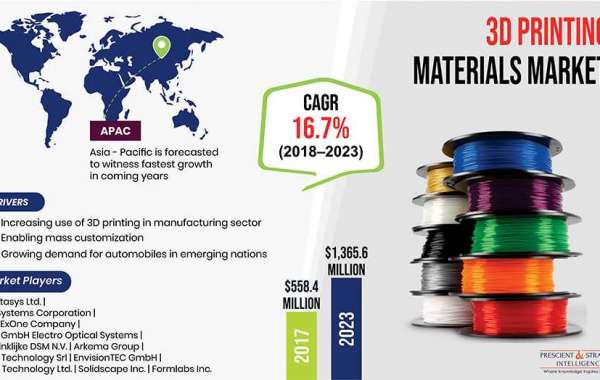In 2017, the global 3D printing materials market generated a revenue of $558.4 million in 2017 and is expected to attain $1,365.6 million in 2023, advancing with a 16.7% CAGR during the forecast period (2018–2023). The market is growing due to the enabling mass customization, rising demand for automobiles in developing countries, and surging use of 3D printing in manufacturing sector. The materials, such as ceramics, metals, and plastics, utilized for 3D printing, which is the printing of 3D objects using sequential layers of materials, are called 3D printing materials.
When form is taken into consideration, the 3D printing materials market is categorized into liquid, powder, and filament. Out of these, the filament category dominated the market during the historical period (2013–2017), holding a share of over 50.0% in 2017, in terms of volume. Polylactic acid and acrylonitrile butadiene styrene are the most widely utilized plastic filaments in 3D printing due to their superior properties, including decreased shrinkage, wrap resistance, high density, and excellent layer adhesion. The category is further projected to hold the largest share of the market during the forecast period.
In terms of application, the 3D printing materials market is divided into medical dental, consumer goods, automotive, aerospace defense, and others (which include art sculpture, food, fashion, architecture, jewelry, and electronics. Among these, the aerospace defense application accounted for the major revenue share of the market during the historical period, holding a share of more than 35.0% in 2017. The reason for this was the use of titanium, which is the most expensive material utilized in 3D printing, in aerospace defense application.
One of the major driving factors of the 3D printing materials market is the rising usage of 3D printing in the manufacturing sector. Manufacturing companies are increasingly focusing on exploring opportunities for integrating additive manufacturing in their processes in order to yield better results. While majority of the companies are using 3D printing for prototyping, aerospace defense and medical dental sectors have started making use of it in full-scale production process. As more companies start utilizing 3D printing for their production process, the demand for 3D printing materials will also increase.
Another primary factor driving the growth of the 3D printing materials market is the increasing requirement for automobiles in developing nations. Countries including India, Indonesia, Brazil, and China are registering swift economic development, which is characterized by the rising purchasing power of individuals. This, in turn, has resulted in increased sales of automobiles in these countries. 3D printing is rapidly gaining traction in the automobile industry for the designing of automotive parts, which is further leading to the growing demand for 3D printing filaments.
A key trend being observed in the 3D printing materials market is the adoption of 3D printing in the education sector. The education sector is embracing the concept of 3D printing as it helps the students to think conceptually and convert their ideas in a physical form. The concept allows students to design basic 3D shapes on their tablets and explore new ideas. Several progressive schools have already integrated 3D printing in their curriculum, as it helps in enhancing the creativity of students and allows them to test their ideas in real space.
Hence, the market is witnessing growth due to the increasing usage of 3D printing in the manufacturing sector and rising demand for automobiles in emerging economies.
Get the Sample Copy of this Report with Detailed Segmentation, Drivers and Opportunity analysis @ https://www.psmarketresearch.com/market-analysis/3d-printing-materials-market/report-sample








